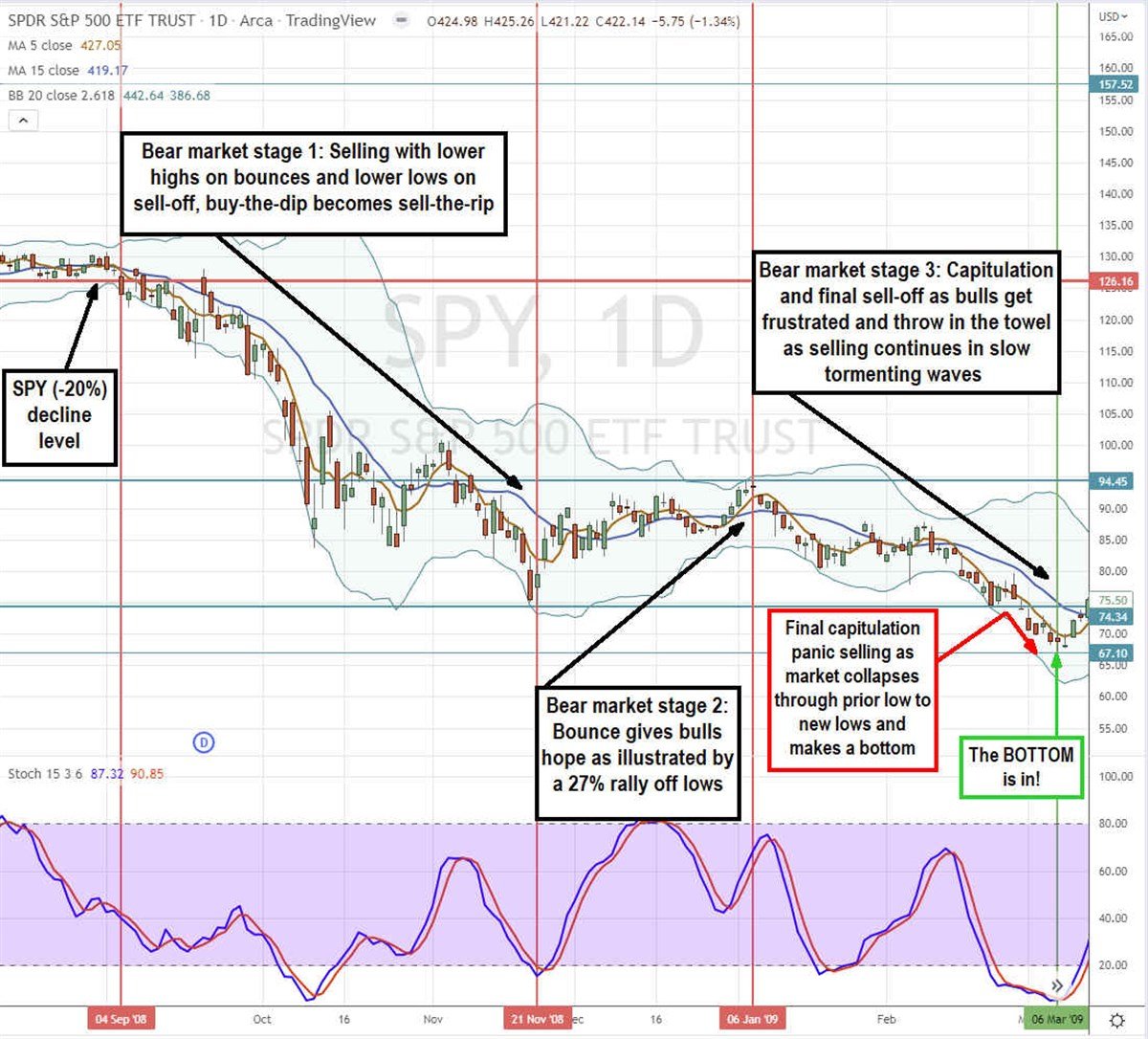Here are the Multiple Stages of a Bear Market The dreaded bear market is technically defined as a period of (-20%) or more declines from its highs lasting at least 60 days.
By Jea Yu
This story originally appeared on MarketBeat

The dreaded bear market is technically defined as a period of (-20%) or more declines from its highs lasting at least 60 days. Bear markets last an average of just over a year while recessions last an average of 17 months, with the longest bear market lasting 630 days from 1973 to 1974. Bear markets tend to foreshadow a recession. The reason why bear markets last less than recessions is that markets tend to react first due to its forward looking nature while recessions are identified and labelled on lagging government GDP reports. We reviewed what to expect in a recession, now let's see what to expect on the stock market side and what to expect during the three stages of a bear market.

Stage 1: The Sell-Off
The first stage tends to occur gradually after making all-time highs and speeds up and transparency materializes. The buy the dip strategy that has been working for years suddenly starts wane as each bounce on a dip gets lower. FOMO kicks in on the initial drops to power a sharp bounce only to sell-off again. Eventually, the robust buying starts to thin out since each bounce rises to a lower high. This begins the downtrend that ultimately materializes into a sell the bounce strategy. Market drops make lower lows while bounces make lower highs, the definition of a downtrend. As stocks continue to fall, panic tends to take over as the magnitude of the selling increases causing investors to worry. Bear market headlines hit the evening news warning of the impending recession causing workers to review their retirement portfolios as fund outflows increase. Buyers go on strike and risk-off positions are taken across the board after a number of attempts to bounce have failed ushering in new lows. Panic ensues on sharp selling. Margin calls and forced liquidations cause large gaps down. Good news results in selling as bad news is catastrophic for stocks. Heavy volume selling reaches a fever pitch as a near-term bottom is put in.
Stage 2: The Reversion Bounce
This stage occurs after a new low is made and the rebound actually holds its ground. After so many bottom attempts, tired bulls aren't convinced or ready to jump in. The market stabilizes and miraculously the bounces continue to hold their gains. Buying becomes more robust as the sell-offs are absorbed by dip buyers. The stock market begrudgingly grinds higher. Eventually, the bulls rejoice and regain their muster and chase entries willing to pay up for a steady rally as they believe the bottom is finally in. Every wave of selling hits a higher floor, which motivates buyers to get in before the last train leaves the station for higher ground.
Stage 3: The Capitulation and a Final Drop
In this final stage, bulls are cheerleading the resiliency of the rebound convinced the market is set to return to its old highs. However, the buying starts to wane again like déjà vu as sellers dump into the rallies again, but not as hard. The market gradually continues lower despite bounces that tend to reverse at common peaks. Complacency kicks in as the market settles in a lower range that eventually breaks lower until the lows are broken. Panic ensues as new lows are made, and bulls throw in the towel after many attempts to catch the bottom failed. Fearing markets will drop even lower, anyone that was going to sell is panicking out of the market as the media paints a "sky is falling" narrative. Indiscriminate selling hits whole sectors hit with waves of panic selling as investors "throw the baby out with the bath water". New bear market lows are put in but hold this time in the height of panic. The only one holding positions are either long-term focused, not paying attention, or don't care anymore as their portfolios are too far down to make a difference now. The bottom is only evident in the rearview mirror as the rally is subtle with markets making a U-shaped bottom if the selling has been prolonged. A V-shaped bottom tends to occur in very fast and sharp declines, like the 2020 pandemic sell-off. The silver ling is that history has proven that all bear markets not only come to an end but continue to spawn robust bull markets. This applies strictly to the benchmark indices, not every individual stock.









